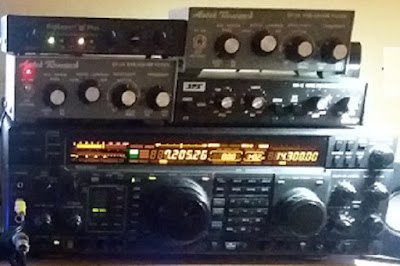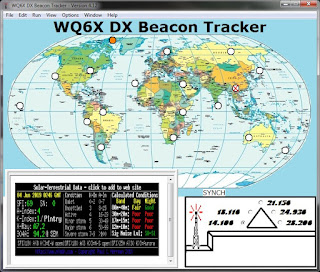 |
| WQ6X testing K6QLF Friday evening |
It is no secret that ARRL Field Day (FD) is in my Top-5 list of favorite radiosport events each year. Beyond multi-OP contest events, FD engages the spirit of cooperative effort like no other operating event each year.
From 1985 until I joined up with N6GEO in Twain Harte (in 2016), I went to great lengths to hook up with the crew @ W6SW. While Geraldine and I made evening appearances on 40 & 75 meter Ssb, my main focus was to put 20-Cw on the air as W6SW himself (and other OPs) made 20-Ssb happen, and Jim W6KC lit up 15-meters on Cw and some Ssb. Of course there was always a GOTA station to handle the 40-meter Ssb duties; we daytime Cw OPs would take turns putting 40-Cw QSOs in the log. One year I reserved "K6F" for the GOTA station; or as Geraldine! ID'd it "Kilowatt 6 Foxytrot!".
In 2012 (with some Australian "encouragement") over 400+ Cw QSOs made it to the 20-m log before dinner time and 20-meter's closing. Later in the evening, "Geraldine" assisted me in creating a ruckus on 40-Ssb and later on 75-meters before calling it quits around 09:00z (2am). Sunday morning, getting up @6AM (I NEVER do that), another 200 20-Cw QSO's made it to the log before FD
ended @ 11am.
While I was new to BLOG writing back in those days some FD events have been
documented, including:
- [o] - W6SW does it's 18th Field Day from Mt. Abel (2013)
- [o] - WQ6X joins team W6SW for its 19th Field Day on Mt. Abel (2014)
- [o] - WQ6X & N6GEO Work 2016 Field Day from Tuolumne County as K6F (2016)
- [o] - WQ6X runs 2017 Field Day solo from W7AYT as W6K
- [o] - WQ6X 2018 FIELD DAY - a dual-OP Solution
Operation with the ARCA group followed by a solo run @W7AYT
In 2018 the visit to K6QLF was considerably easier considering the close proximity of the operation
in Alameda - because I was the photogger, my mug was not a part of the picture.
For 2019, I strongly considered a return to W6SW on the mountain (they did not operate last year). The drive from San Fernando Valley to Mt. Abel is enough of a chore as it is. The thought of loading up a vehicle with radios and camping gear followed by a 300 mile drive was not my idea of a leisurely time. An invite from the ARCA club was all it took to convince me to take it easy. When I heard that we would be operating from the Aeolian yacht harbor in Alameda (I.e. close to home-base) and that the Ssb station (I.e. me) would be operating from a 42' sailboat in the harbor, the decision became
a no-brainer.
Tom (WB6RUC) provided the 42' Catalina and a "place to park it". The weekend before FD we
test-ran a cobbled-together ICOM 7000 running thru an SGC-257 auto tuner to a 55' Marconi (I.e. end-fed) sloper-wire to the top of the mast, allowing me to run part of the All Asia contest from the boat. ([CLICK HERE] to read about that.) Although the All Asia event from the boat was largely a bust (the antenna favored N, N/E, E & S/E and not Asia) it turned out to be excellent prep for running FD the following weekend.
The ICOM 7000 is a feature-loaded radio. Because I haven't played with one in over 5+ years, the learning curve was a bit steep; altho easily remedied by way of the RTFM method using the excellent ICOM manual, as well as the Nifty mini manuals. Once I got back into the "groove" I thoroughly enjoyed the numerous DSP features built-in to the radio.
Later Friday evening I rearranged the equipment structure on the galley table making it easier to access the computer and the audio filter knobs. The rest of the evening was spent tuning the bands, checking signal levels and getting used to running "stereo Cw" with the ICOM 7000; something I've never done before. While the ICOM's DSP is 2nd to none in its class, the addition of stereo cw takes things to the next level, making frequency running considerably more effective than without it.
By Saturday 8am, ARCA members were at it setting up the "land" stations. As you can see, I helped out with raising an OCFD dipole antenna for the ICOM 7300 station indoors. It's the least I could do.
Afterwards, it was back to the boat and assembling a goofy hamstick-dipole I brought along as a backup antenna.
Because this year's FD was a more involved event than last year (or even the GiGs on Mt. Abel), I've decided to document the event in several BLOG entries.
This 1st part takes us right up to the 11am start. It got WAY more interesting as the day moved forward. Stay Tuned for Part 2.
Did YOU work the 2019
Radio Amateur's Field Day?
Is K6QLF in YOUR LoG?
Part 2 of this BLOG has just been published. [CLICK HERE] to read it.

















































